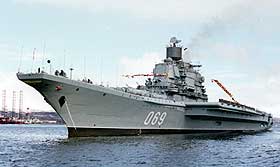Russian military experts forecast that Western nations will have 80,000 cruise missile by 2020.
"We expect Western countries to have at least 80,000 cruise missiles by 2020, including about 2,000 of them nuclear-powered," Gen. Igor Sheremet said in an interview with the Ekho Moskvy radio station.
"We expect Western countries to have at least 80,000 cruise missiles by 2020, including about 2,000 of them nuclear-powered," Gen. Igor Sheremet said in an interview with the Ekho Moskvy radio station.
He added these missiles are clearly not simply designed for drilling or intimidation purposes. "They can deliver disarming or even 'decapitation' strikes," Sheremet said.
Hence, he said, the plans to develop Russia's air and space defense system in 2011 as instructed by President Dmitry Medvedev in November. The new system will combine the existing air defense and missile defense networks, missile early-warning systems and airspace monitoring systems under a unitified strategic command.
In mid-February, Valery Ivanov, commander of the strategic command of the new air and space defense system, said the system would be set up and start operating by the end of 2011.
The Russian political and military leadership have long considered plans to develop strong missile and space defenses by 2020, but no concrete steps have been taken so far and the country does not even have a well-defined command structure to tackle this problem.
According to one proposal, the unified aerospace defense command will absorb some air defense units which are currently part of the Russian Air Force, and Space Forces units.
The Russian military plans to build a comprehensive air and space defense network consisting of S-400 Triumf and future S-500 air defense systems and the Soviet-era MiG-31 Foxhound supersonic interceptors.
The S-500 system is expected to have an extended range of up to 600 km (over 370 miles) and simultaneously engage up to 10 targets. The system will be capable of destroying hypersonic and ballistic targets.
Russia's leading missile manufacturer Almaz-Antei said last March that it was developing at least six types of advanced air defense systems to be available for the Russian military in around 2015.



































